Here’s What Icewine Harvesting in Niagara Wine Country Looks Like
Icewine is a unique sweet wine made from grapes that have been left to freeze naturally on the vine. The taste is like liquid gold.
Here’s What Icewine Harvesting in Niagara Wine Country Looks Like
Icewine is a unique sweet wine made from grapes that have been left to freeze naturally on the vine. The taste is like liquid gold.
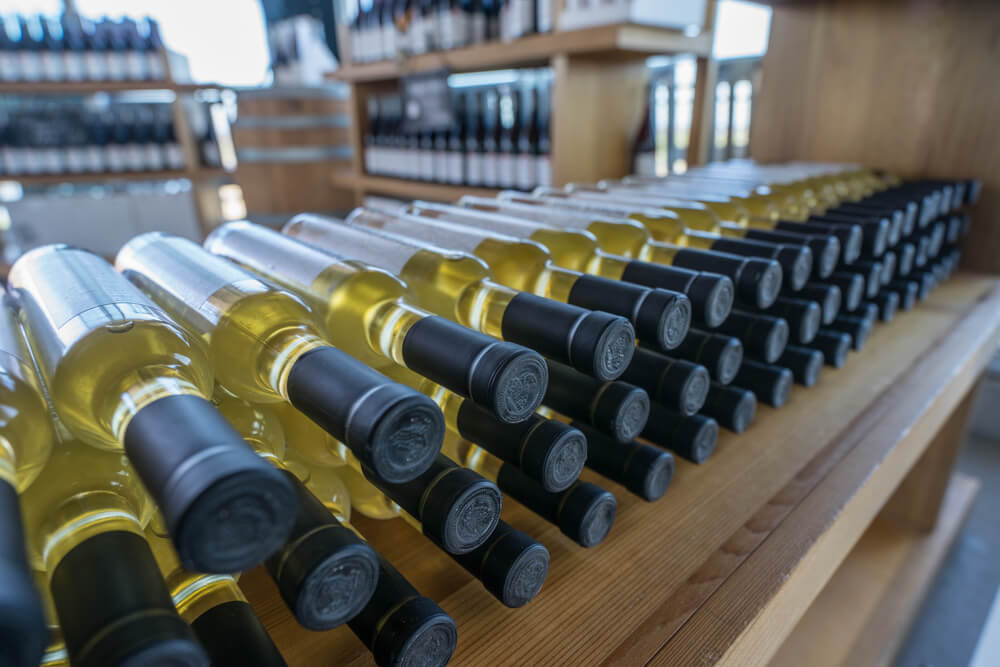
Niagara Icewine BottlesChris Cramer Photography / Shutterstock
Canada is a global leader for Icewine production, and 95% of that Icewine is made in Niagara, Ontario. We took a road trip to witness the frigid harvest.
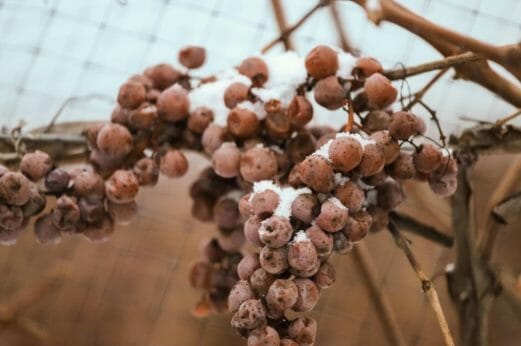
Icewine got its start in Canada in the early 1980s. With close to ideal climate conditions (warm summers to ripen grapes coupled with not too cold winters), Ontario is where it’s at for creating Icewine. The appellations of the Niagara Peninsula, Prince Edward County and Lake Erie North Shore boast mostly limestone-based shale, and clay loam. Again, pretty ideal conditions. While about 60 local wineries produce it, grapes for Icewine comprise only about 15% of Ontario’s annual crop.

In preparation for Icewine season, the grape vines are netted in the autumn when the grapes are ripening to protect them from being snatched by birds. In November, the grapes must be registered with VQA (Vintners Quality Alliance) inspectors, whereupon the grape variety, acreage and estimated tonnage are verified. The grapes are then left on the vine until a sustained temperature of minus 8 degrees Celsius or lower is reached. Depending on the season, this could happen anytime from December to February. (Here, the writer braves the cold for about 20 minutes of fake harvesting for a photo op.)
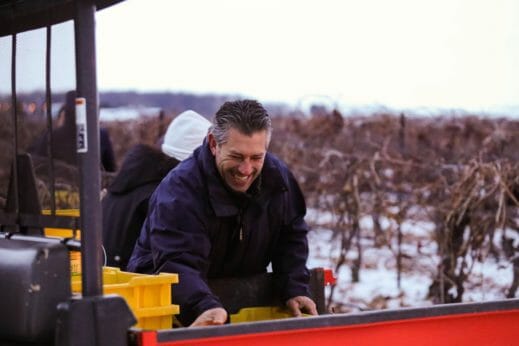
During Icewine season, wineries and grape growers like Trevor Falk of Falk Vineyards, keep a careful watch on the weather forecast, looking for a stretch of temperatures between -10 and -12 °C. This specific range will produce juice in the range of 35 to 39 ° Brix (roughly equivalent to the percent sugar in the juice). Typically, a period of at least 6 hours is needed to harvest and press the grapes – and it’s usually an overnight job. Still, Trevor keeps on smiling.
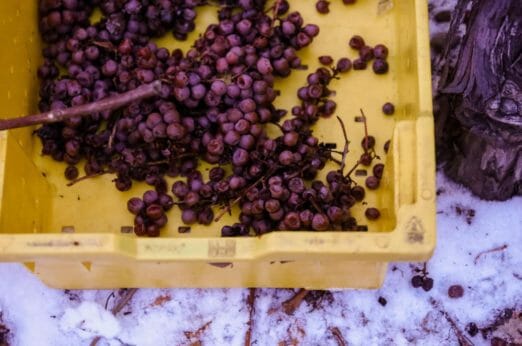
During the time between the end of the growing season and harvest, the grapes dehydrate and the juices are concentrated and develop the characteristic complexity of Icewine. The typical varietals used for Icewine in Ontario are Vidal, Riesling and Cabernet Franc. They thrive here.
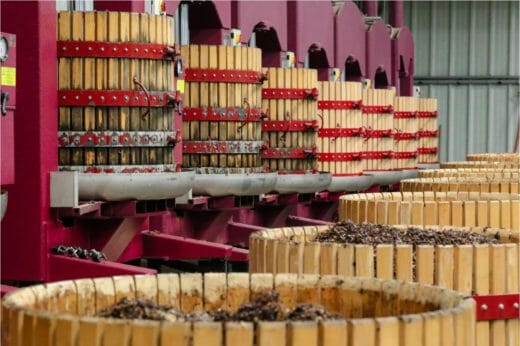
Once the grapes are harvested, they are pressed in small hydraulic presses under higher pressure than is normal for grapes harvested during the regular season. That’s because these grapes are frozen; most of their mass is water and is left behind as ice in the press. Only a small amount of concentrated juice is extracted.
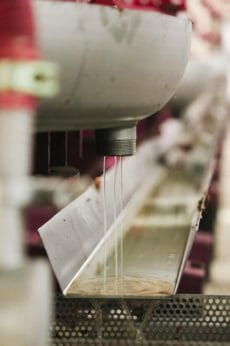
Pressed while still frozen, the grapes yield a sweet concentrated juice that is incredibly flavourful; almost like a nectar. Look at how thick that looks.

Imagine if grape juice tasted like cotton candy, sunshine and rainbow ponies all wrapped into one delicious gulp? That’s what this freshly pressed Icewine juice tastes like. “Enjoy every drop,” says Falk Vineyards patriarch, Bill Falk. “That glass is worth about $8 of Icewine,” he winks.
Follow us
This work is licensed under a Creative Commons Attribution-NoDerivatives 4.0 International License.
Want to republish a Modern Farmer story?
We are happy for Modern Farmer stories to be shared, and encourage you to republish our articles for your audience. When doing so, we ask that you follow these guidelines:
Please credit us and our writers
For the author byline, please use “Author Name, Modern Farmer.” At the top of our stories, if on the web, please include this text and link: “This story was originally published by Modern Farmer.”
Please make sure to include a link back to either our home page or the article URL.
At the bottom of the story, please include the following text:
“Modern Farmer is a nonprofit initiative dedicated to raising awareness and catalyzing action at the intersection of food, agriculture, and society. Read more at <link>Modern Farmer</link>.”
Use our widget
We’d like to be able to track our stories, so we ask that if you republish our content, you do so using our widget (located on the left hand side of the article). The HTML code has a built-in tracker that tells us the data and domain where the story was published, as well as view counts.
Check the image requirements
It’s your responsibility to confirm you're licensed to republish images in our articles. Some images, such as those from commercial providers, don't allow their images to be republished without permission or payment. Copyright terms are generally listed in the image caption and attribution. You are welcome to omit our images or substitute with your own. Charts and interactive graphics follow the same rules.
Don’t change too much. Or, ask us first.
Articles must be republished in their entirety. It’s okay to change references to time (“today” to “yesterday”) or location (“Iowa City, IA” to “here”). But please keep everything else the same.
If you feel strongly that a more material edit needs to be made, get in touch with us at [email protected]. We’re happy to discuss it with the original author, but we must have prior approval for changes before publication.
Special cases
Extracts. You may run the first few lines or paragraphs of the article and then say: “Read the full article at Modern Farmer” with a link back to the original article.
Quotes. You may quote authors provided you include a link back to the article URL.
Translations. These require writer approval. To inquire about translation of a Modern Farmer article, contact us at [email protected]
Signed consent / copyright release forms. These are not required, provided you are following these guidelines.
Print. Articles can be republished in print under these same rules, with the exception that you do not need to include the links.
Tag us
When sharing the story on social media, please tag us using the following: - Twitter (@ModFarm) - Facebook (@ModernFarmerMedia) - Instagram (@modfarm)
Use our content respectfully
Modern Farmer is a nonprofit and as such we share our content for free and in good faith in order to reach new audiences. Respectfully,
No selling ads against our stories. It’s okay to put our stories on pages with ads.
Don’t republish our material wholesale, or automatically; you need to select stories to be republished individually.
You have no rights to sell, license, syndicate, or otherwise represent yourself as the authorized owner of our material to any third parties. This means that you cannot actively publish or submit our work for syndication to third party platforms or apps like Apple News or Google News. We understand that publishers cannot fully control when certain third parties automatically summarize or crawl content from publishers’ own sites.
Keep in touch
We want to hear from you if you love Modern Farmer content, have a collaboration idea, or anything else to share. As a nonprofit outlet, we work in service of our community and are always open to comments, feedback, and ideas. Contact us at [email protected].by Amy Rosen, Modern Farmer
February 11, 2019
Modern Farmer Weekly
Solutions Hub
Innovations, ideas and inspiration. Actionable solutions for a resilient food system.
ExploreExplore other topics
Share With Us
We want to hear from Modern Farmer readers who have thoughtful commentary, actionable solutions, or helpful ideas to share.
SubmitNecessary cookies are absolutely essential for the website to function properly. This category only includes cookies that ensures basic functionalities and security features of the website. These cookies do not store any personal information.
Any cookies that may not be particularly necessary for the website to function and are used specifically to collect user personal data via analytics, ads, other embedded contents are termed as non-necessary cookies.
Upon seeing the operation first hand, I look forward to educating myself further by receiving your news letter.
Je cherche du travaille au canada